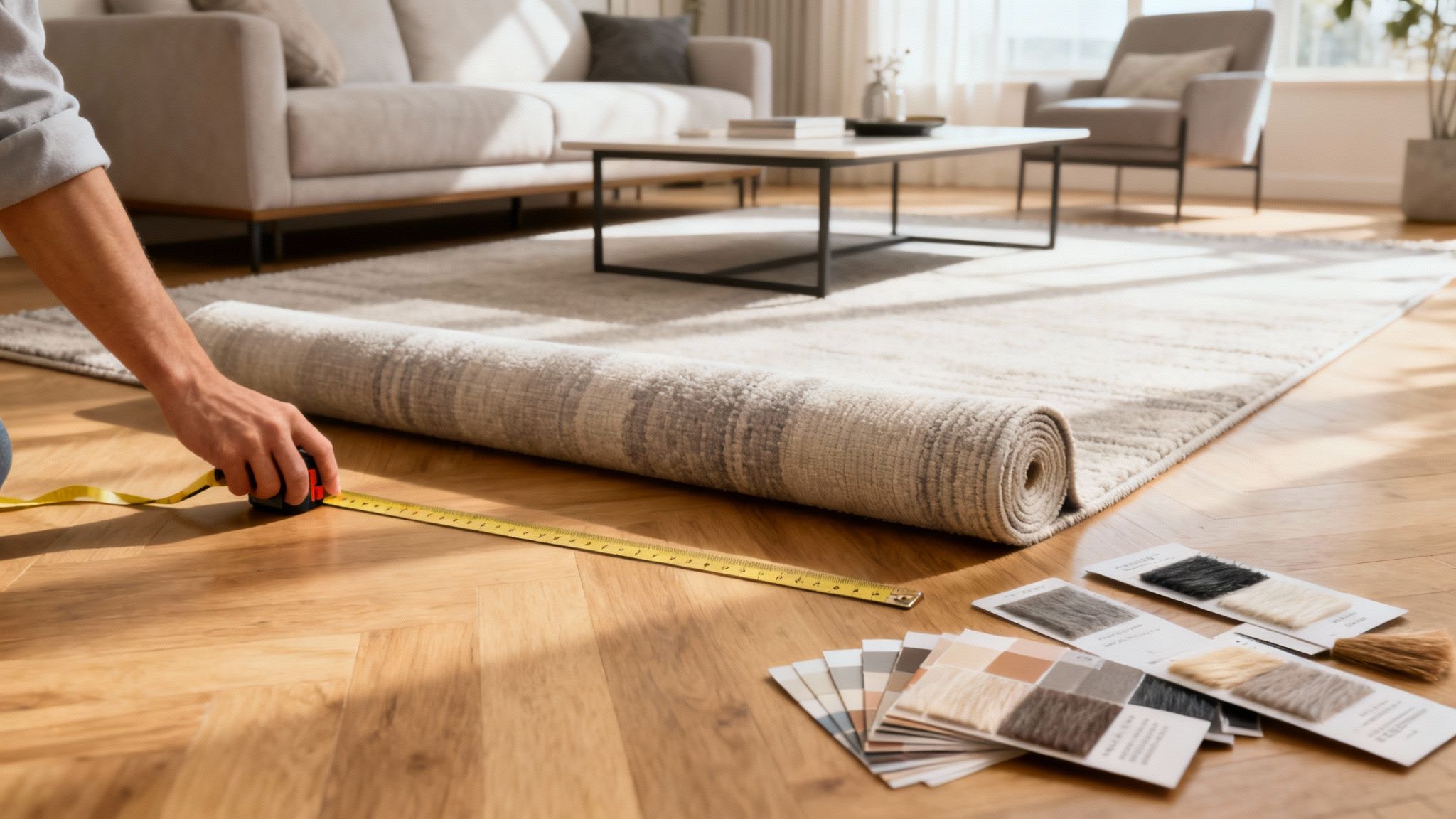A well-designed deck is the heart of many British gardens, offering a perfect spot for relaxation and entertainment. What truly brings it to life, however, is the greenery. This guide moves beyond simple pots scattered on the floor to explore transformative decking planter ideas that integrate plants into the very fabric of your outdoor living area. We have curated a collection of eight innovative approaches, from seamless built-in designs that merge with your deck’s structure to clever, space-saving vertical solutions perfect for smaller footprints.
Each concept is presented with practical, actionable tips to help you create a lush, stylish, and functional deck garden that feels both personal and professionally designed. Whether you have a sprawling terrace or a cosy, compact balcony, you'll find inspiration to think differently about cultivating colour, texture, and life right on your doorstep. This isn't just about placing pots; it’s about creating a cohesive, living extension of your home. Let's delve into the designs that will redefine your outdoor space and elevate your approach to container gardening this year.
1. Built-in Deck Planters
For the ultimate seamless and high-end finish, built-in deck planters are integrated directly into your deck's structure. This approach involves constructing planter boxes as an extension of the deck frame, often using the exact same materials, such as composite boards or treated timber. The result is a cohesive, architectural feature that makes your greenery appear as an organic part of the original design, rather than a later addition.
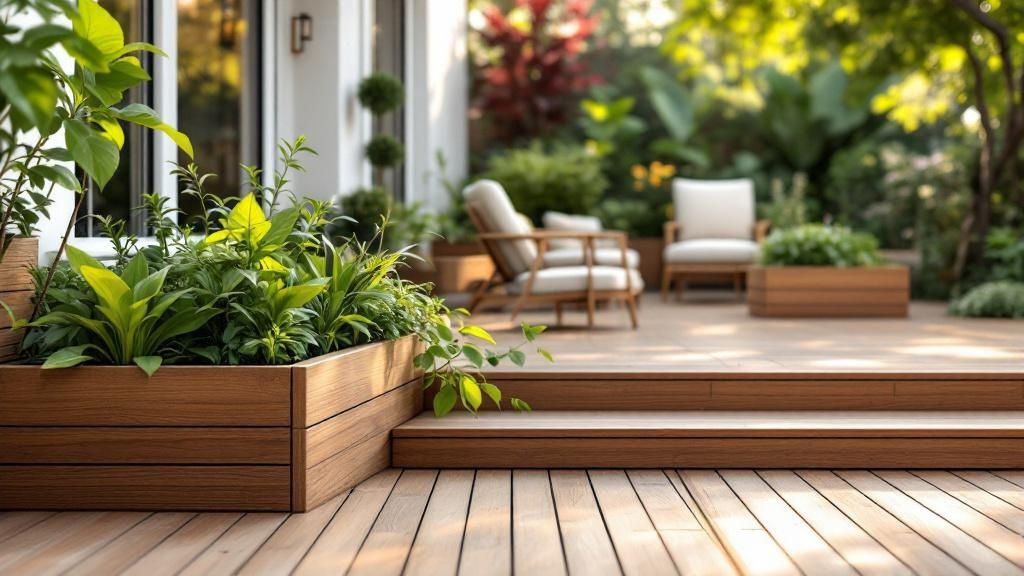
This method is ideal for new deck constructions or major renovations where you can plan the layout from the start. Popularised by landscape architects and TV renovation shows, this concept is one of the most effective decking planter ideas for creating defined zones, such as framing a seating area or lining a perimeter for privacy. Imagine a sleek composite deck with planters that double as bench seating, or a multi-level cedar deck where the steps are flanked by tiered herb gardens. While this is a more permanent solution, you can find inspiration for DIY wooden structures in many places; you can even explore simple pallet wood projects to practise your skills.
Key Implementation Tips
To ensure longevity and healthy plants, proper construction is crucial. Follow these actionable steps for a successful built-in planter:
- Ensure Proper Drainage: Line the bottom of the planter with a generous layer of gravel before adding soil. Drill multiple drainage holes in the base to prevent waterlogging, which can lead to root rot and damage the deck structure.
- Protect Your Deck: Fit a high-quality, waterproof liner inside the planter. This essential barrier prevents moisture from seeping into the timber or composite frame, stopping rot and preserving the integrity of your deck.
- Plan for Plant Needs: Consider the root depth of your chosen plants. A shallow box is fine for annuals, but shrubs or small trees will require a much deeper soil bed.
- Think About Access: Design the planters with maintenance in mind. Ensure you can easily reach all areas for watering, pruning, and replanting without awkward stretching.
2. Tiered Corner Planters
Corner spaces on a deck are often awkward and underutilised, but tiered corner planters transform these neglected spots into stunning vertical gardens. This smart design features multiple levels or steps, allowing you to create a lush, cascading display of foliage and flowers. By building upwards, you maximise planting capacity without sacrificing valuable floor space, making it one of the most efficient decking planter ideas for smaller decks.
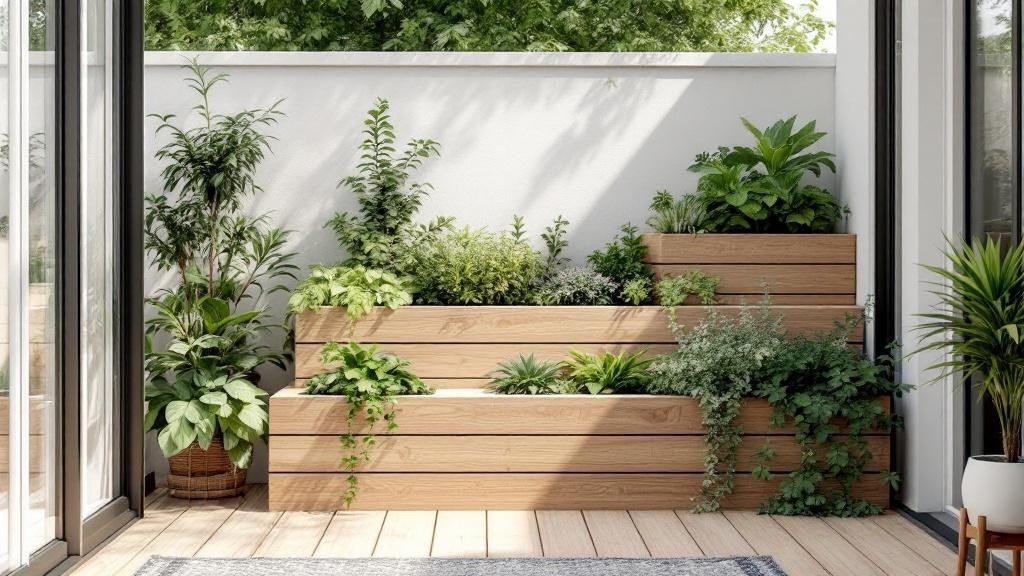
This method is perfect for adding height and dimension to your deck's design. Freestanding units are widely available in various materials, from rustic wood to modern metal, offering flexibility to move them as needed. Alternatively, a custom-built tiered planter can be integrated into the corner for a more permanent, seamless look. Imagine a three-tier herb garden right outside your kitchen door, a vibrant display of cascading petunias adding a splash of colour, or a structured arrangement of succulents in a geometric planter. This approach allows for creative combinations, turning a dull corner into a dynamic focal point.
Key Implementation Tips
To get the most out of your tiered corner planter and keep your plants thriving, focus on strategic setup and thoughtful plant selection. Follow these actionable steps for a beautiful and healthy display:
- Plan Your Planting by Level: Arrange plants based on their needs. Place sun-loving varieties on the top tier where they will receive the most light, and shade-tolerant plants on the lower levels. Also, consider growth habits: trailing plants are perfect for the edges to create a cascading effect.
- Use a Lightweight Potting Mix: A large, multi-level planter filled with standard soil can become extremely heavy. Opt for a lightweight potting mix, which often contains perlite or vermiculite, to reduce the overall weight load on your deck structure.
- Ensure Adequate Spacing: When planting, remember to account for the mature size of each plant. Overcrowding can lead to poor air circulation and competition for resources, so give them enough room to grow and fill out naturally.
- Consider Drip Irrigation: Watering multiple levels can be tricky, with water often running off the top tiers before soaking in. Installing a simple drip irrigation system ensures each level receives consistent and adequate moisture, simplifying your maintenance routine.
3. Railing Planter Boxes
Railing planter boxes are a clever solution for maximising greenery without sacrificing valuable floor space on your deck. These specialised containers are designed to hang over or attach directly to deck railings, instantly transforming a functional barrier into a vibrant, living feature. Available in a huge range of materials from modern recycled plastic to classic wrought iron, they make it easy to introduce cascading flowers, fragrant herbs, or lush trailing plants at eye level.
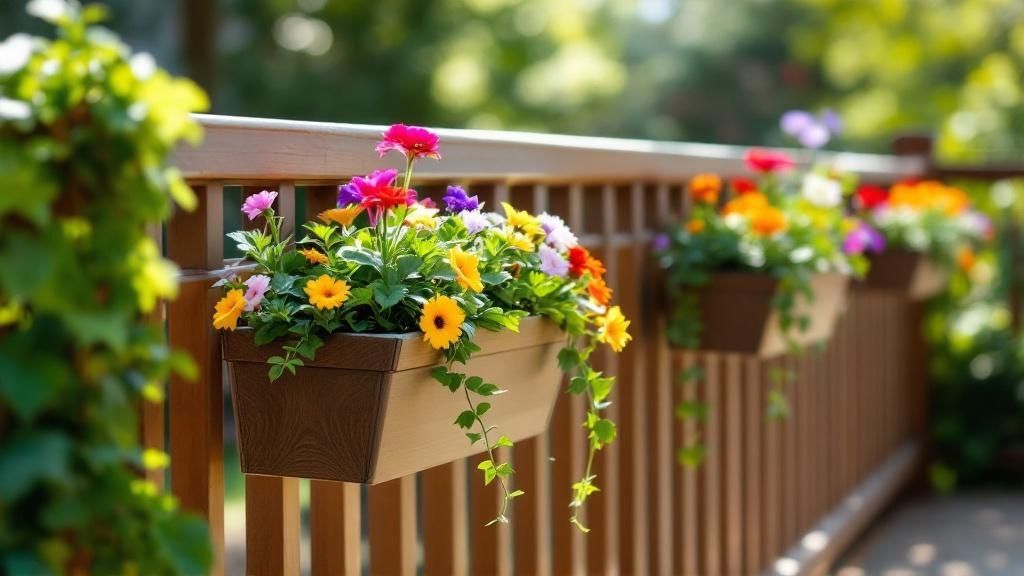
This approach is one of the most versatile decking planter ideas, perfect for small decks, balconies, or any space where ground area is at a premium. Popularised by brands like Gardener's Supply Company and the creative DIY gardening community on Pinterest, railing planters add vertical interest and a pop of colour exactly where it's needed most. Imagine a row of terracotta-style troughs overflowing with vibrant petunias, or sleek black planters filled with kitchen herbs just outside your door for easy access. They are particularly effective for creating a sense of enclosure and privacy on an otherwise exposed deck.
Key Implementation Tips
To get the most from your railing planters while ensuring they are safe and your plants thrive, consider these practical tips:
- Choose Suitable Plants: Railing planters are typically shallow, so opt for plants with smaller root systems. Annuals like geraniums, lobelia, and trailing ivy are excellent choices, as are most common herbs like mint, basil, and parsley.
- Prioritise Drainage and Lining: Good drainage is essential. Use coconut coir or sphagnum moss liners inside wire-frame planters to retain moisture while allowing excess water to escape. For solid planters, ensure they have adequate drainage holes.
- Ensure a Secure Fit: Double-check that the planter's mounting brackets fit your railing's width securely. For added peace of mind, especially in windy areas, use zip ties or safety cables to provide an extra anchor point.
- Group for Impact: A single, lonely planter can look sparse. Create a more dramatic and lush display by grouping several planters together along a railing section. This creates a continuous line of colour and foliage that has a far greater visual effect.
4. Mobile Rolling Planters
For ultimate flexibility and versatility on your deck, mobile rolling planters are a dynamic solution. These are essentially freestanding containers fitted with heavy-duty casters, allowing you to effortlessly move your plants around. This adaptability makes them one of the most practical decking planter ideas, enabling you to chase the sun, protect plants from harsh weather, or instantly reconfigure your space for entertaining guests. The concept, popularised by the urban gardening movement and adaptations from the commercial greenhouse industry, transforms your deck into a modular, ever-changing garden.
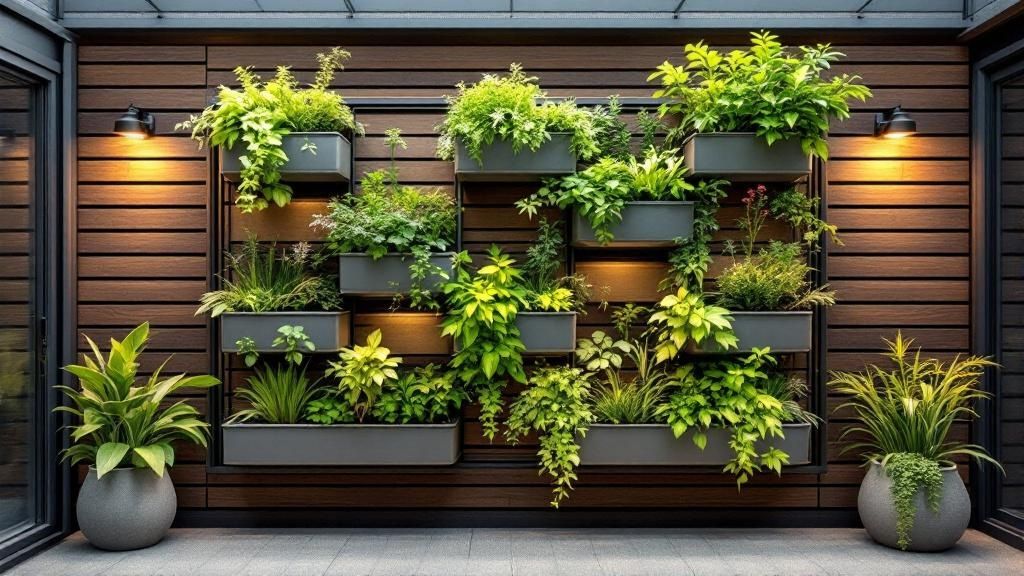
This method is perfect for renters or anyone who enjoys redesigning their outdoor layout frequently. From sleek, self-watering models like those from LECHUZA to rustic custom-built cedar boxes with industrial wheels, the options are vast. You can create a movable privacy screen with tall grasses, roll a herb garden closer to the kitchen door when cooking, or simply clear the entire deck for a party. These planters offer a brilliant, commitment-free way to experiment with different arrangements, and their easy-to-manage nature aligns well with other low-maintenance garden ideas.
Key Implementation Tips
To get the most out of your rolling planters and ensure safety, careful selection and planning are key. Follow these actionable steps for success:
- Choose Lockable Wheels: This is non-negotiable, especially for windy or slightly sloped decks. Lockable casters prevent your planters from rolling away unexpectedly, ensuring they stay exactly where you put them.
- Factor in Total Weight: Remember to calculate the weight of the planter when it's full of damp soil and mature plants. Ensure the casters are rated for this load and that your deck structure can support the concentrated weight.
- Protect Your Deck Surface: Place deck protector mats or coaster-like "plant trolleys" under the wheels. This prevents the casters from leaving marks, scuffs, or indentations on your timber or composite decking over time.
- Plan Your Routes: Before buying large planters, consider how you will move them around. Ensure there are clear pathways between furniture and other fixtures to avoid a frustrating game of garden Tetris.
- Consider Overwintering: The mobility of these planters is a huge advantage in cold climates. You can easily roll them into a garage or sheltered area to protect perennial plants from freezing temperatures.
5. Vertical Living Walls
For decks where floor space is at a premium, vertical living walls transform bare walls, railings, or fences into vibrant, productive gardens. This innovative approach uses modular systems, fabric pockets, or stacked containers to grow a dense tapestry of plants upwards, maximising your growing area without sacrificing valuable deck space. The result is a stunning, green feature that adds visual interest, texture, and even privacy to your outdoor living area.
This method is ideal for urban balconies, small decks, or anyone looking to create a high-impact focal point. Popularised by botanist Patrick Blanc and embraced by the urban farming movement, this concept is one of the most efficient decking planter ideas for growing herbs, salads, and trailing flowers. Imagine a wall-mounted pocket system by your outdoor kitchen overflowing with fresh mint and basil, or a freestanding tower bursting with colourful annuals. For those interested in creating a unique backdrop, you can explore how to build a garden wall feature to get started.
Key Implementation Tips
To ensure your living wall thrives, careful planning and setup are key. Follow these actionable steps for a successful vertical garden:
- Ensure Adequate Structural Support: A fully watered living wall is incredibly heavy. Securely mount the system to a structurally sound wall or fence, using appropriate anchors and fixings that can handle the combined weight of the structure, soil, and plants.
- Install Drip Irrigation: Consistent watering is the biggest challenge for vertical gardens. Installing a simple drip irrigation system with a timer ensures every plant receives the moisture it needs without manual effort, preventing dry spots and overwatering.
- Use a Lightweight Growing Medium: Traditional soil can be too heavy. Use a lightweight, soilless potting mix containing perlite, coco coir, and compost to reduce the overall weight and improve drainage and aeration for healthy roots.
- Plan for Sun and Succession: Observe how the sun hits the wall throughout the day. Place sun-loving plants at the top and shade-tolerant ones lower down. Plan for seasonal changes by swapping out annuals to keep the display looking fresh all year.
6. Multi-Level Bench Planters
For a solution that is as practical as it is beautiful, multi-level bench planters combine functional seating with dynamic integrated planting areas. This clever design merges garden furniture with your greenery, creating a dual-purpose feature that saves space and enhances the usability of your deck. The structure typically involves a bench with planter boxes built in at the ends, behind the backrest, or at varying heights to create a tiered effect.
This approach is one of the most efficient decking planter ideas for smaller spaces, as it maximises every square inch. It’s perfect for creating a cosy, enclosed seating nook or for defining the edge of a deck without a traditional railing. Imagine an L-shaped corner bench with a tall planter behind it for privacy screening, or a straight bench flanked by two planter boxes filled with colourful flowers and aromatic herbs. These functional designs are a hallmark of smart, compact garden layouts, and you can find more inspiration for maximising small outdoor areas by exploring creative terrace house garden ideas that share similar principles.
Key Implementation Tips
To get the most out of your bench planter, thoughtful design and plant selection are key. Follow these actionable tips for a successful and comfortable feature:
- Prioritise Seating Comfort: Ensure the bench portion is a standard, comfortable height, typically around 40-45 cm (16-18 inches) from the deck surface. The depth should also be sufficient for comfortable seating, usually at least 45 cm.
- Choose Seating-Friendly Plants: Select plants that won't interfere with the seating area. Avoid anything thorny, spiky, or overly bushy that might encroach on guests. Low-maintenance perennials and fragrant herbs like lavender or rosemary are excellent choices.
- Incorporate Proper Drainage: Like any container, the planter sections require robust drainage to prevent water from pooling, which can cause root rot and damage the bench structure. Drill ample holes and line the base with gravel.
- Plan for Sun and Shade: Consider the orientation of the bench. Position plants that need full sun in the sunniest parts of the planter and use the shadier spots for plants that prefer less direct light.
7. Hanging Basket Gardens
For a classic and space-efficient approach, hanging basket gardens lift your greenery off the deck floor, creating beautiful aerial displays. This method involves suspending planters from overhead structures like pergolas, roof eaves, or specially installed brackets. The result is a multi-layered garden that adds vertical interest and a sense of lushness without sacrificing valuable floor space, making it one of the most versatile decking planter ideas.
This idea is perfect for smaller decks or for adding a pop of colour and texture above seating areas. Drawing inspiration from Victorian conservatories and the bohemian macrame trend of the 1970s, hanging planters can suit any style, from traditional coco-fibre baskets overflowing with petunias to sleek, modern ceramic pots in minimalist hangers. They are especially effective for drawing the eye upward and can even create a subtle privacy screen when grouped together. Some hanging systems can be adapted for lower light conditions; you can even find plants that thrive in darker spaces for a shaded corner of your deck.
Key Implementation Tips
To ensure your hanging garden is both beautiful and secure, careful installation and plant selection are essential. Follow these actionable steps for a thriving aerial display:
- Ensure a Secure Anchor: Use heavy-duty, rust-proof hooks or brackets rated to hold the weight of a fully watered plant. Always screw them into a solid structural element like a joist or beam, not just the cladding.
- Plan for Water Runoff: Hanging baskets can drip onto the deck or furniture below after watering. Position them thoughtfully over garden beds at the deck's edge or use integrated drip trays to catch excess water.
- Choose the Right Plants: Select trailing plants like fuchsias, ivy geraniums, or lobelia to create the classic cascading effect. For a fuller look, combine them with upright plants like begonias in the centre.
- Create Visual Interest: Don't hang all your baskets at the same level. Group them in clusters of two or three at varying heights to create a more dynamic and professionally styled composition. Consider the wind exposure, as suspended plants can dry out quickly.
8. Modular Container Systems
For ultimate flexibility and a modern, cohesive aesthetic, modular container systems offer a sophisticated way to organise your deck garden. This approach uses standardised, often interlocking, planter components that can be arranged, stacked, and reconfigured at will. The uniform shapes and sizes allow you to create custom layouts that feel intentionally designed, from a simple trio of planters to a complex, multi-level green wall.
Popularised by German design innovators and the Scandinavian minimalist movement, this is one of the most versatile decking planter ideas for evolving spaces. Think of the LECHUZA CUBE planter collection, where self-watering cubes can be grouped to form a sleek herb garden, or custom-built matching wooden boxes that can be rearranged to define different zones on your deck as your needs change. This system is perfect for renters or anyone who enjoys refreshing their outdoor layout seasonally without a permanent commitment.
Key Implementation Tips
To get the most out of a modular system, focus on creative arrangement and plant selection. Follow these actionable tips for a dynamic and stylish display:
- Group in Odd Numbers: For a more natural and visually appealing arrangement, group your modular planters in threes or fives. This avoids a rigid, symmetrical look and creates a more organic feel.
- Vary Heights and Textures: While the containers are uniform, the plants within them shouldn't be. Combine tall, architectural plants like grasses with trailing varieties and low-growing flowers to create depth and visual interest.
- Start Small and Expand: Begin with a core set of three to five planters. As you become more confident with the system and understand your space, you can gradually add more pieces to expand your garden.
- Mix Sizes from the Same Family: Many modular ranges offer different sizes within the same design. Mixing large and small containers from the same collection adds dimension while maintaining a cohesive look.
Decking Planter Ideas Comparison Table
Bringing Your Deck Garden to Life
Your deck is far more than just an outdoor floor; it is a canvas awaiting your personal touch. Throughout this guide, we have explored a diverse range of decking planter ideas, each offering a unique way to infuse your space with life, colour, and character. From the seamless integration of built-in planters that merge with your deck's architecture to the dynamic flexibility of mobile rolling containers, the possibilities are designed to suit every style and spatial constraint.
We've seen how vertical living walls can turn a plain surface into a stunning botanical masterpiece and how railing boxes can add a splash of charm without sacrificing precious floor space. The dual-functionality of multi-level bench planters and the customisable nature of modular systems demonstrate that great design is about both beauty and practicality. Your journey now is to take these concepts and adapt them to your unique environment.
Your Action Plan for a Greener Deck
To move from inspiration to implementation, consider these final actionable steps:
- Assess Your Space: Before purchasing anything, take a final look at your deck. Identify high-traffic areas, note the sun's path throughout the day, and measure the exact dimensions you have to work with. This practical assessment will narrow down your options to the most suitable ones.
- Define Your Style: Do you envision a modern, minimalist oasis or a rustic, cottage-style retreat? Your choice between sleek metal planters, warm wooden benches, or colourful ceramic pots should align with your home's overall aesthetic and the atmosphere you wish to create.
- Plan Your Planting Palette: The planters are only half of the equation. Consider the plants themselves. Create a cohesive look by choosing a colour scheme or a specific theme, such as an edible herb garden, a pollinator-friendly flower display, or a low-maintenance succulent collection. Remember to pair plants with similar light and water requirements.
By thoughtfully applying these decking planter ideas, you are not just adding decoration; you are crafting an experience. You are building a personal sanctuary for relaxation, a vibrant backdrop for entertaining guests, and a living extension of your home that evolves with the seasons. The ultimate goal is to create a space that feels uniquely yours, a verdant retreat just a few steps from your door. Now is the perfect time to start planting and watch your dream deck garden flourish.


